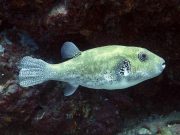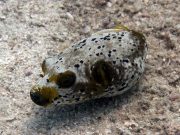Diving with Pufferfishes
Lanta Marine Life | Tetraodontidae
Pufferfish are a common sight on all of the coral reefs during Koh Lanta dive trips. They typically have round faces, tapered bodies and big eyes, ranging in size from 2 cm to around 1 m in length. Pufferfish are easily spotted when diving around Koh Lanta, however they are one of the most toxic fish in the ocean and should not be eaten.
Puffers have the ability to gulp water and sometimes air to inflate their bodies into a giant ball when threatened. It is believed that they developed this tactic as a method of self defence, due to their very poor swimming ability.
A predator that manages to snag a puffer before it inflates won't feel lucky for long. Almost all pufferfish contain 'tetrodotoxin', a toxin that makes them lethal to most predators. It can be found in their organs, skin and spines depending on species. Only a few animals are immune to the toxin, such as Sharks and Sea Snakes. To humans, it is deadly, up to 1,200 times more poisonous than cyanide and with no known antidote, there is enough toxin in one pufferfish to kill 30 adult humans!
Puffers have densely packed teeth, giving a fused, or beak-like appearance. These very sharp teeth are used to pry open molluscs, eat invertebrates and scrape algae. They are believed to synthesise their deadly toxin from the bacteria in their food.
When a puffer reaches maturity, the male will lead the female close to the shore, where they release and fertilise only 3-7 eggs. The young will stay here until big enough to join the reef.
5 species found on this page:
Blackspotted Pufferfish
(Arothron nigropunctatus)
The blackspotted, or dog-face puffer is a common sight at all of our dive sites and easy to identify. This small fish has no scales and grows up to 33 cm, but more commonly observed around 20 cm. Sometimes seen alone, sometimes in pairs. This fish has a short snout, no pelvic fin and both a small dorsal and anal fin.

Arothron nigropunctatus @ Koh Haa
Blackspotted pufferfish colouration is highly variable, greyish, bluish, blackish, yellowish, however they all have a few common markings such as black lips, black around the pectoral fin base and scatterings of different sized black spots on the body.
Instead of "teeth," blackspotted puffers have 4 strong teeth in a beak-like structure which they use to crush crustaceans and mollusks, crunch sponges and the tips of branching corals.
Starry Pufferfish
(Arothron stellatus)

Arothron stellatus @ Koh Haa
The starry pufferfish is the largest of all puffers, growing up to 1.2m. This fish has no scales, with the body covered with prickles. This fish has a short snout, no pelvic fin and both a small dorsal and anal fin.
Adults are white with many small black spots, juveniles have fewer, larger spots. Young fish are orange with small black spots and black stripes on the belly, becoming spots as they age.
Usually seen alone, the starry puffer feeds on sea urchins, starfish, sponges, crabs, corals and algae. Sometimes seen swimming high above the corals or seabed. The starry puffer is extremely poisonous, and tetrodotoxin may occur in the muscle, intestine, liver, gonads and skin. Do not try to eat this fish.
Blue-spot Pufferfish
(Arothron caeruleopunctatus)

Arothron caeruleopunctatus @ Koh Haa
The Blue-spot Pufferfish has a yellowish, brown to grey back, lighter below, and covered in small white to blue spots.
There are alternating dark and light rings around the eyes, and the pectoral fin base has a black patch with white spots.
As with other Pufferfishes, the Blue-spot Pufferfish has a small dorsal and anal fin and the teeth are fused into four beak-like parts. The Blue-spot Pufferfish grows to 70 cm.
Scribbled Pufferfish
(Arothron mappa)

Arothron mappa @ Koh Haa
The scribbled, or 'map' puffer is a medium size fish growing up to 65 cm, but often observed smaller than this.
The background coloration is whitish with dense network of black broken lines and lines radiating from the eyes.
The scribbled pufferfish has a large black blotch around the gill opening, and a black blotch on the lower side.
As with the other puffers listed here, this fish has no scales, with the body covered with prickles.
This fish has a short snout, four beak-like teeth, no pelvic fin and both a small dorsal and anal fin. It is also highly toxic.
Spotted Toby
(Canthigaster solandri)

Canthigaster solandri @ Koh Haa
The Spotted Toby has a brownish body colour, covered with white to blue to green spots.
There are white to blue to green line markings on the snout and back. There is on ocellated spot on the dorsal fin base.
The Spotted Toby grows to 10 cm and is found in sheltered reef areas and often found in pairs.
The Spotted Toby fish feeds on algae, coral polyps and bottom-dwelling invertebrates such as molluscs (slugs & snails), echinoderms (sea urchins, sea stars) and polychaetes (bristle worms).
Diving with Pufferfishes around Koh Lanta
Scuba Diving & Snorkel Trips
If you'd love a chance to spot Pufferfishes on one of our daily high season diving trips from Koh Lanta then send us an email to info@diveandrelax.com.
Join our high season speedboat dive trips to some of Thailand's best dive sites and enjoy small groups, short journey times, with a focus on great personal service, safety and fun.
Not yet a certified diver? Learn to Scuba Dive on Koh Lanta with the 3 day SSI Open Water Diver course.
Book online to save 10% on dive trips and scuba courses on Koh Lanta.
Find Out More
Indo-Pacific Marine Life Guides
- Allen, G., Steene, R., Humann, P., DeLoach, N. (2003) Reef Fish Identification, Tropical Pacific. Jacksonville, FL., USA: New World Publications, Inc., ISBN 1-878348-36-1.
- Humann, P., DeLoach, N., (2010) Reef Creature Identification, Tropical Pacific. Jacksonville, FL., USA: New World Publications Inc., ISBN 978-1-878348-44-9
- Debelius, H. (2013) Indian Ocean Reef Guide. Frankfurt, Germany: IKAN - Unterwasserarchiv, ISBN 978-3-939767-52-7.
- Debelius, H. (2004) Nudibranchs and Sea Snails, Indo-Pacific Field Guide. Frankfurt, Germany: IKAN - Unterwasserarchiv, ISBN 3-925919-51-1
- Erhardt, H., Knop, D. (2015) Corals Indo-Pacific Field Guide. Frankfurt, Germany: IKAN - Unterwasserarchiv, ISBN 3-925919-69-4.
- Veron J.E.N., Stafford-Smith M.G., Turak E. and DeVantier L.M. (2016). Corals of the World


